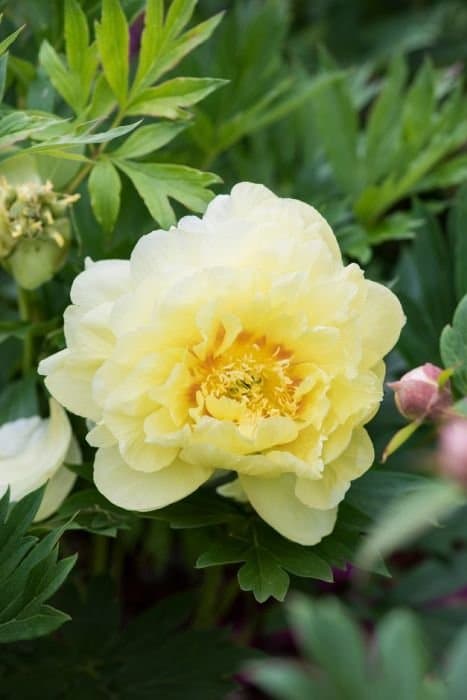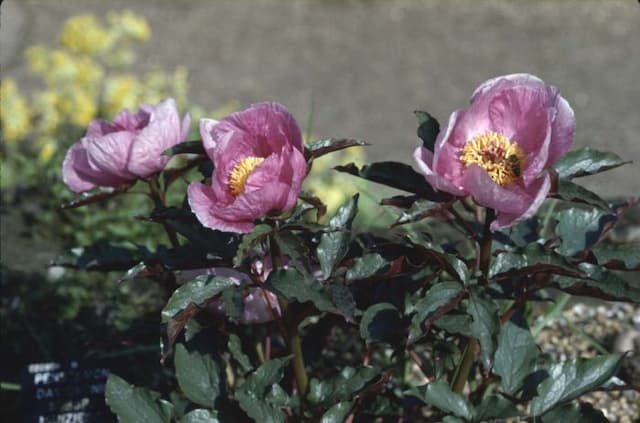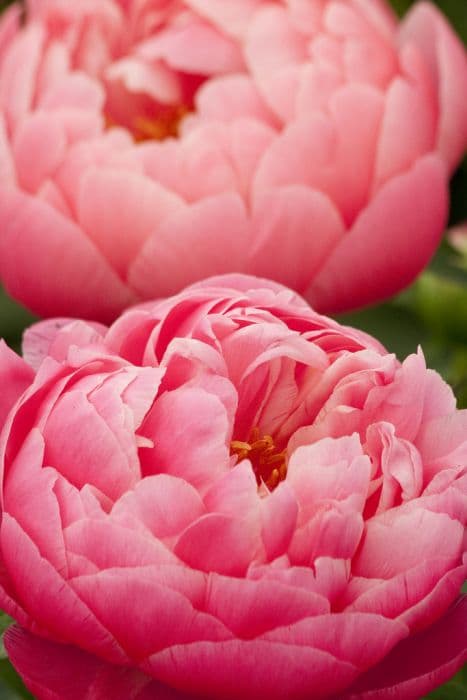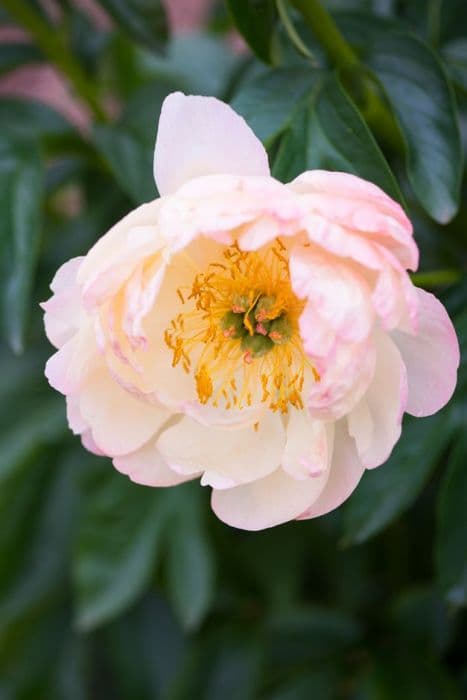Garden Peony Paeonia lactiflora 'Do Tell'

ABOUT
The 'Do Tell' variety of common peony is adorned with distinctive flowers that boast a captivating form and palette. Each flower presents an outer ring of soft pink petals that can range in shade from a pale, almost blush hue, to a more pronounced, lively pink. These outer petals cradle a chaotic cluster of inner petals and staminodes that brighten the center of the bloom with a mix of pink, cream, and sometimes a peachy tone. The inner petals can be narrow, petal-like, or have a somewhat feathery appearance, which adds to the fluffy, ruffled look of the flower. This particular peony has a somewhat less dense look compared to other double-flowered peonies, allowing glimpses into its intricate center and offering a delicate balance of elegance and complexity. The leaves of the plant are a deep green, providing a lush background for the striking blooms. They typically emerge in the springtime, with the flowers themselves gracing gardens with their beauty in late spring to early summer. The foliage remains attractive throughout the growing season, often turning to a reddish color in the fall, thus extending the plant's visual interest beyond its blooming period. The overall appearance of the 'Do Tell' peony makes it a much-appreciated addition to flower beds, borders, and as a specimen in gardens where its charming blossoms can be admired up close.
About this plant
 Names
NamesFamily
Paeoniaceae
Synonyms
Chinese Peony, Common Garden Peony
Common names
Paeonia lactiflora 'Do Tell'.
 Toxicity
ToxicityTo humans
Peonies, such as the Paeonia lactiflora 'Do Tell', are not considered highly toxic to humans. Nevertheless, if ingested, parts of the plant can cause mild gastrointestinal upset, such as nausea or diarrhea. It's important to note that peonies contain compounds that might be irritating to some individuals if ingested or handled excessively. In general, though, they are not known for being severely poisonous to humans.
To pets
Peonies, including the Paeonia lactiflora 'Do Tell', are considered mildly toxic to pets when ingested. Consumption can lead to gastrointestinal irritation, resulting in symptoms such as vomiting and diarrhea. While they are not considered severely toxic, it is still advisable to prevent pets from consuming peonies to avoid these potential complications.
 Characteristics
CharacteristicsLife cycle
Perennials
Foliage type
Deciduous
Color of leaves
Green
Flower color
Pink
Height
2 feet 4 inches (0.7 meters)
Spread
2 feet 4 inches (0.7 meters)
Plant type
Herb
Hardiness zones
3-8
Native area
Asia
Benefits
 General Benefits
General Benefits- Aesthetic appeal: Paeonia lactiflora 'Do Tell', commonly known as Chinese peony, has attractive, vibrant flowers that can enhance the beauty of gardens and landscapes.
- Longevity: Once established, the Chinese peony is a long-lived perennial that can provide beauty to a garden for decades.
- Cut flower use: The Chinese peony's large and fragrant blooms make excellent cut flowers, often used for floral arrangements and bouquets.
- Seasonal interest: With its springtime blossoms, the Chinese peony adds seasonal interest to garden spaces, signaling the arrival of warmer weather.
- Garden design versatility: Due to its lush foliage and elegant flowers, the Chinese peony can be incorporated into a variety of garden designs, including borders and cottage gardens.
- Low maintenance: Once established, Chinese peonies require minimal care, with infrequent watering and fertilizing needs.
- Cold tolerance: The Chinese peony is hardy in many climates and can tolerate cold winters, making it suitable for gardens in temperate regions.
- Pollinator attraction: The blooms of Chinese peony attract bees and other pollinators, aiding in the health of the garden ecosystem.
- Deer and rabbit resistance: Chinese peonies are generally resistant to browsing by deer and rabbits, reducing the need for protective measures.
 Medical Properties
Medical Properties- Anti-inflammatory: Traditionally used in Chinese medicine to reduce inflammation.
- Analgesic: Used to relieve pain in various conditions, according to traditional remedies.
- Immunomodulatory Effects: Some compounds in Paeonia lactiflora may affect the immune system.
- Antispasmodic: May help alleviate muscle cramps and spasms.
- Antioxidant: Contains compounds that can help protect the body from oxidative stress.
- Hepatoprotective: Believed to have protective effects on the liver.
- Neuroprotective: Potential effects in protecting nerve cells from damage.
 Air-purifying Qualities
Air-purifying QualitiesThis plant is not specifically known for air purifying qualities.
 Other Uses
Other Uses- Paeonia lactiflora 'Do Tell', commonly known as Peony 'Do Tell', can be used as a natural fabric dye, imparting a soft beige to pink color to textiles depending on the mordant used.
- In culinary practices, the petals of the Peony 'Do Tell' are sometimes crystallized with sugar and used as edible decorations for cakes and desserts.
- Peony 'Do Tell' petals are used in crafting eco-friendly confetti for weddings and celebrations, fully biodegradable and considered more environmentally friendly than paper or plastic.
- The blossom petals can be floated in water bowls as a decorative and fragrant table centerpiece for special occasions or as a daily aesthetic touch.
- With its attractive flowers, the Peony 'Do Tell' serves as a natural photographic subject for botanical art and illustration, providing inspiration for artists and photographers.
- Peony 'Do Tell' petals can be incorporated into hand-made soaps for a natural touch of color and a hint of fragrance, adding value to homemade cosmetics.
- The dried seed pods of Peony 'Do Tell' can be used in flower arrangements, providing an interesting texture and shape contrast to other elements.
- In crafting, the sturdy stems of the spent Peony 'Do Tell' flowers can be repurposed in homemade wreaths and other decorative items.
- Peony 'Do Tell' plants can be used in permaculture designs as a perennial border plant, helping to define the structure of a garden while contributing to biodiversity.
- Leaves of the Peony 'Do Tell' can be used as a natural canvas for botanical impression art, where the intricate veining of the leaves creates interesting patterns.
Interesting Facts
 Feng Shui
Feng ShuiThe peony is considered a symbol of wealth, prosperity, and honor in Feng Shui. To use the peony in Feng Shui, place the plant or images of the flower in the southwest corner of your garden or home to promote love and romance, or in the southeast to attract abundance and financial success. However, it should be avoided in the bedroom for singles, as it can amplify singlehood.
 Zodiac Sign Compitability
Zodiac Sign CompitabilityThe peony is not used in astrology practice.
 Plant Symbolism
Plant Symbolism- Prosperity: The peony is often associated with riches and honor, reflecting its full, round blooms that symbolize an abundance of wealth and success.
- Romance: With its lush and fragrant flowers, the peony is a symbol of romantic love and is a popular choice in wedding bouquets and decorations, suggesting blissful marriage and companionship.
- Honor: In many cultures, peonies are seen as a representation of honor and high esteem, possibly due to their association with nobility in past societies.
- Beauty: The peony, often admired for its impressive and striking appearance, symbolizes the ideal of feminine beauty.
- Compassion: Some interpretations suggest that peonies embody compassion due to their lush, full petals and soft, inviting colors, indicating a gentle and empathetic nature.
- Wealth: Similar to prosperity, the fullness of the bloom is often correlated with material wealth, indicating financial blessings or aspirations.
 Water
WaterThe common name for Paeonia lactiflora 'Do Tell' is 'Garden Peony' and it should be watered deeply once a week, allowing the soil surface to dry out slightly between waterings. During the growing season, provide about 1 inch of water weekly, which translates to about 0.623 gallons per square foot if you are using a watering can or hose. It's important to avoid overhead watering to prevent fungal diseases, so water at the base of the plant. In hotter, drier periods, you may need to water more frequently to maintain consistent soil moisture, and less during rainy seasons.
 Light
LightGarden Peonies require a sunny spot with at least six hours of direct sunlight daily to thrive. Partial shade in the hottest part of the day is acceptable, but too much shade can result in weak stems and reduced flowering. A location receiving morning sun and afternoon shade is ideal for peonies like 'Do Tell'.
 Temperature
TemperatureGarden Peonies are quite cold-hardy and can survive winter temperatures as low as -30°F. They require cold to enter dormancy and to set buds for the following season. The ideal temperature for growing peonies is between 65°F and 75°F during their growing season. Hot temperatures above 90°F can lead to stress and may require additional watering to keep the plants healthy.
 Pruning
PruningGarden Peonies benefit from pruning to remove spent flowers and to cut back the foliage to the ground after it has died back in the fall. This helps to reduce disease and allows the plant to focus energy on root development. Peonies should be pruned back after the first frost and before the growth starts again in the spring. Deadheading, or removing spent flowers, can be done throughout the blooming period to keep the plant looking tidy.
 Cleaning
CleaningAs needed
 Soil
SoilThe best soil mix for Peony 'Do Tell' should be well-draining with good organic content. Adding compost or well-rotted manure to the soil will improve its fertility. The soil pH suitable for Peonies ranges from 6.5 to 7.0, slightly acidic to neutral. A mix of garden soil, compost, and perlite or vermiculite can provide the right texture and nutrition.
 Repotting
RepottingPeony 'Do Tell' typically does not need to be repotted often as it is a perennial garden plant. It prefers to be left undisturbed and can thrive in the same location for years. If necessary, division and repotting should occur in the fall, approximately every 10 to 15 years, to maintain vigor.
 Humidity & Misting
Humidity & MistingPeony 'Do Tell' is tolerant of a wide range of humidity levels and does not require specific humidity conditions. As long as it is planted outdoors in appropriate soil, ambient humidity will generally suffice for its growth.
 Suitable locations
Suitable locationsIndoor
Peonies struggle indoors; provide cool temperatures, bright light, and plant in well-draining soil.
Outdoor
Full sun, well-drained soil, plant root 2 inches below surface. Mulch lightly.
Hardiness zone
3-8 USDA
 Life cycle
Life cycleThe Paeonia lactiflora 'Do Tell', commonly known as the Chinese Peony 'Do Tell', begins its life cycle as a dormant tuberous root that is planted in the fall. During early spring, reddish shoots emerge from the soil, signaling the start of the growth season. As the weather warms, the plant develops sturdy stems and large, compound leaves, followed by distinctive, fluffy pink to blush flowers that typically bloom in late spring to early summer. After flowering, seeds are produced in pods that, if left on the plant, can mature by late summer and potentially give rise to new plants. Throughout summer, the foliage provides a backdrop to other plants in the garden until late autumn when the leaves yellow and die back. The plant then enters dormancy during winter, withdrawing energy back into the roots for the following spring's growth cycle.
 Propogation
PropogationPropogation time
Early Fall
Propogation: Paeonia lactiflora 'Do Tell', more commonly referred to as Chinese peony, is most commonly propagated through root division. This process is ideally done in the fall after the plants have gone dormant. The clump of the peony should be carefully dug up and the soil removed from around the roots. With a sharp knife, the clump is then divided into sections, ensuring that each division has at least three to five buds, commonly known as "eyes," and a portion of the root system attached. The divisions should be planted in well-draining soil with the eyes positioned about 1 to 2 inches below the soil surface (approximately 2.5 to 5 centimeters). Adequate spacing of about 2 to 3 feet (60 to 90 centimeters) between plants allows for proper air circulation and growth. After planting, the divisions should be watered thoroughly to help establish the new plants.









